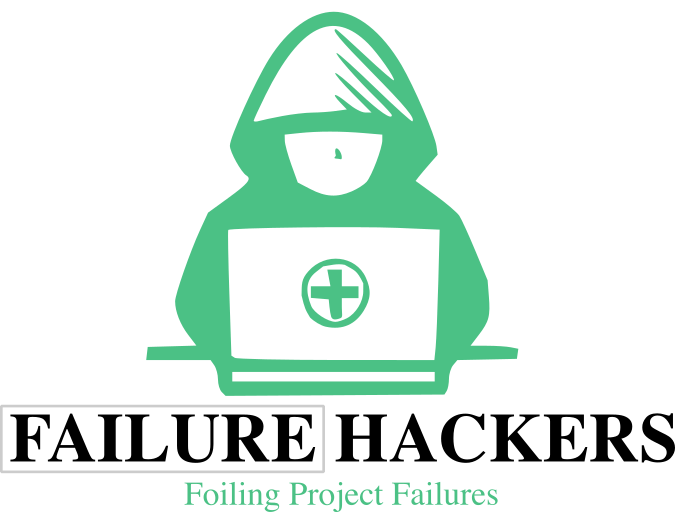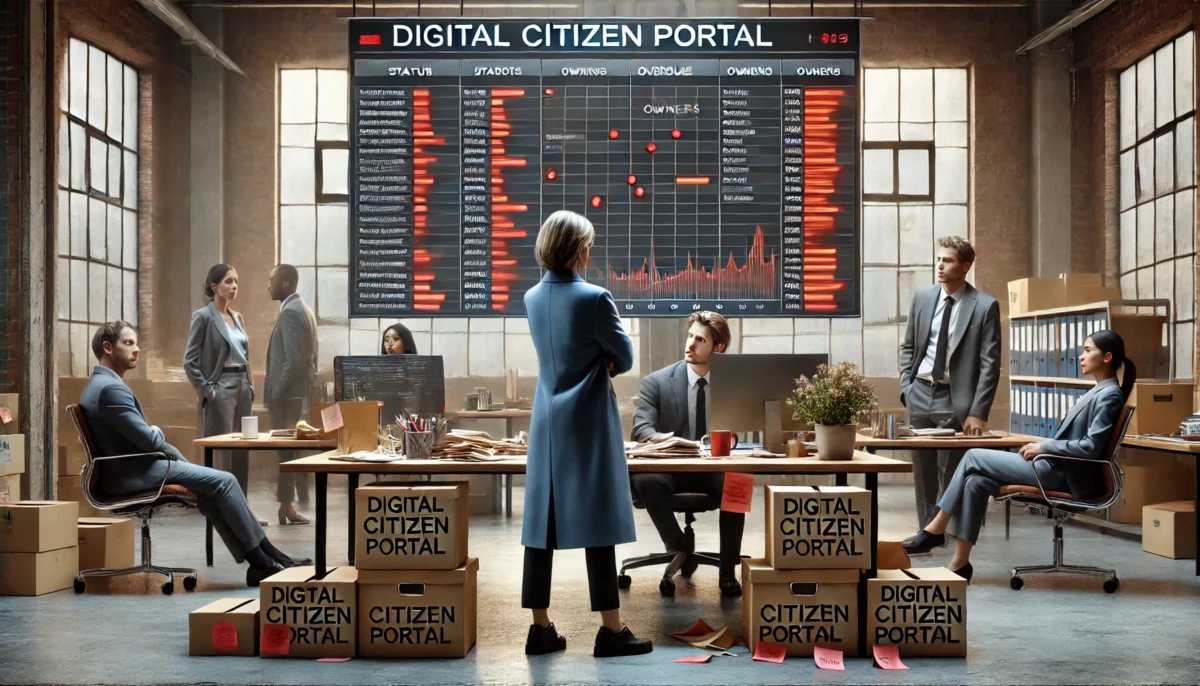1. Monday Morning Panic
Lisa Hughes stared at the screen.
Her project tracker looked like a crime scene: amber flags turning red, tasks overdue, owners missing. The “Digital Citizen Portal” — a key part of the council’s transformation programme — was supposed to go live in three weeks.
Instead, deliverables were quietly vanishing.
She scrolled again, heart sinking. No updates from content design, no sign-off from procurement, and the supplier’s milestone report hadn’t arrived. Yet every meeting last week ended with the same cheery line: “We’re on track.”
Lisa wasn’t new to trouble. In ten years of delivery management across local government, she’d seen enough projects drift. But…
Something about this one felt slippery — like trying to hold water in her hands.
Everyone seemed busy, yet nothing moved.
2. The Stand-Up That Went Sideways
At the daily stand-up, the team gathered in their usual horseshoe:
- Tom from IT, muttering about API dependencies.
- Priya from Comms, juggling content approvals.
- Ahmed, the supplier’s PM, camera off on Teams as always.
“Okay,” Lisa started, trying to sound calm. “Let’s go around — what’s blocking progress?”
Silence. A few shuffled papers.
Then Tom said, “We can’t move forward on integration until the service owner signs off the data fields.”
Priya frowned. “I thought that was approved?”
“It was,” Tom said, “but Legal raised something new about GDPR.”
“That’s news to me,” Priya said. “Who’s dealing with Legal now?”
“Not me,” said Tom. “That’s Ops.”
“No,” said Lisa, “Ops said they only handle the data hosting, not content capture.”
The conversation spiralled. By the time they finished, they’d agreed to “pick it up offline” — which, Lisa knew, meant no one would.
She closed the call and opened her notebook. In big letters she wrote:
Who actually owns what?
3. Rewinding the Tape
Later that afternoon, Lisa met with her programme manager, Hannah.
“Everyone’s working hard,” Lisa said, “but no one’s accountable. We’ve got three teams, four departments, and two suppliers. Each thinks the other’s got it.”
Hannah nodded. “Classic council matrix. We set up governance last year, remember? There’s a steering group.”
“Right,” said Lisa. “But the steering group thinks they’re ‘advisory’. The delivery teams think the steering group owns decisions. It’s a hall of mirrors.”
“Okay,” said Hannah. “Map it. Who’s responsible for what?”
That word — map — sparked something. Lisa opened her laptop and sketched a grid. Across the top: “Responsible, Accountable, Consulted, Informed.” Down the side: every deliverable she could name — procurement plan, API integration, content approval, accessibility testing.
It was messy, but it was a start.
4. The RACI Revelation
By the next morning, Lisa’s desk was covered in scribbled RACI notes.
She’d colour-coded roles — blue for supplier, green for council staff, yellow for the PMO. Patterns leapt out immediately.
- Procurement tasks: nobody marked as “Accountable.”
- Content design: two people marked “Responsible.”
- Data governance: six different “Consulted” parties, but no decision-maker.
No wonder everything was stalling. Every decision had dissolved into endless consultation.
She shared the chart with Hannah. “It’s worse than I thought. Everyone’s touching everything, but no one’s driving it.”
Hannah exhaled slowly. “Okay. Let’s fix ownership first. Then we’ll worry about deadlines.”
They called a meeting with all leads. Lisa projected the RACI on the screen.
“I’m not here to blame anyone,” she said. “But we need clarity. Who’s actually on the hook for each deliverable?”
There was awkward laughter. Someone joked about “too many cooks.” But as they went line by line, the mood shifted. People started volunteering to take clear roles.
By the end, they had a new version. For the first time, it looked sane.
5. When One Fire Hides Another
Two days later, another issue surfaced.
The supplier missed yet another milestone. Ahmed finally joined the call, apologetic but vague. “There’s a dependency on your infrastructure team,” he said.
Lisa frowned. “Which one?”
“The data services group,” he said. “They haven’t provisioned the new environment.”
“I wasn’t aware that was blocking you,” she said.
“Well, we raised it in our internal report,” Ahmed replied.
Lisa opened the shared folder. No sign of any report.
After the call, she sat back and thought: Every time we fix one issue, another appears. It felt reactive, like treating symptoms instead of curing the disease.
So she pulled out a blank page and wrote a question she often used when problems got slippery:
“Why?”
Then below it:
“Why is the supplier missing milestones?”
Because dependencies aren’t managed.
Why aren’t they managed?
Because no one has visibility.
Why not?
Because updates are trapped in private reports.
Why are reports private?
Because no one agreed how progress should be shared.
Four “whys” later, she had the root cause: lack of a shared information flow.
6. Drawing the Map
Lisa booked a half-day workshop called “How the Work Really Works.”
Using a whiteboard, she drew circles for each group: supplier, IT, Comms, Legal, PMO, and Service Owner. She asked each to mark the teams they interacted with most often. Lines criss-crossed the board until it looked like a spider’s web.
Then she asked, “Where does information get stuck?”
That question changed everything.
The Legal team admitted they only heard about data decisions at the eleventh hour.
Comms revealed they didn’t know when supplier updates were due.
The supplier said they never saw PMO dashboards, so they couldn’t align milestones.
In an hour, they’d built a living Stakeholder Map — showing not hierarchy, but flow.
They agreed to create a shared “single source of truth” dashboard and new update rhythm. For the first time, the fog began to lift.
7. Turning the Tide
Two weeks later, the difference was visible.
The dashboard updates ran every Friday. Each owner posted their progress openly. There was friction at first — nobody likes exposure — but soon the transparency became normal.
When blockers emerged, people tackled them fast instead of burying them.
At one meeting, Tom said, “Before, I didn’t know who to chase. Now I can see exactly who’s responsible for what.”
Priya added, “And it’s not personal anymore — it’s just clear.”
The supplier hit its next milestone on time. The portal’s beta launch date stabilised. For the first time in months, the delivery tracker looked like it might tell the truth.
Lisa didn’t relax — she’d learned that projects can slip quietly again if you stop watching — but she felt control returning.
8. The Quiet Victory
On launch morning, Lisa arrived early.
The new Digital Citizen Portal went live at 9:00 a.m. sharp.
There were a few teething issues — a broken link here, a login glitch there — but nothing catastrophic.
By midday, the Chief Information Officer sent an email: “Congratulations — solid delivery. Thank you all.”
Lisa smiled at her screen. She knew it wasn’t perfect, but the win wasn’t the portal itself. It was that the team had finally built trust and visibility — foundations that would last longer than any launch.
Reflection: What Really Happened Here
The problem looked like missed deliverables, but the real issue was unclear ownership and hidden communication flows.
Lisa’s story shows how easily complex projects drift when responsibility blurs and updates vanish into silos.
The tools that helped her turn it around were simple — but powerful when applied together:
- RACI Matrix: surfaced the lack of clear accountability.
- Five Whys: uncovered the deeper cause — a missing information-sharing structure.
- Stakeholder Mapping: made the invisible relationships visible, showing where communication needed redesign.
The turnaround didn’t come from heroics. It came from seeing the system clearly — and then deliberately redesigning how people worked within it.
Author’s Note
This story illustrates how structured clarity tools — like the RACI Matrix, Five Whys, and Stakeholder Mapping — can shift a struggling project from confusion to control.
They sit within the Failure Hackers problem-solving lifecycle, moving from “symptom recognition” through “diagnosis” to “countermeasure.”
When projects feel chaotic, start by making ownership visible, ask why until you find the real barrier, and then map the relationships that keep information moving.
That’s how small moments of clarity turn into sustainable success.

